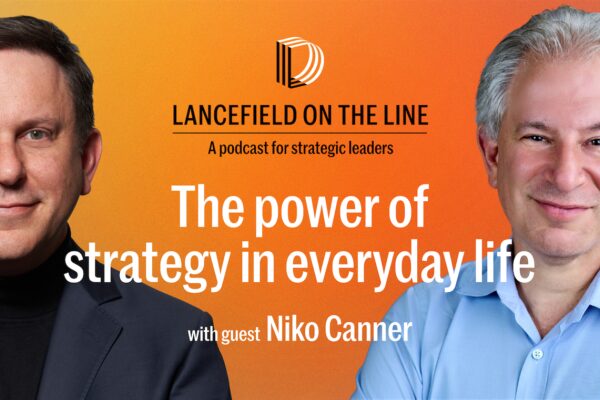
Last year, we had the honor to work with the team at Solutions Journalism Network, helping them define their strategy.
Co-founders David Bornstein, Tina Rosenberg and Courtney Martin, and their team, have a very large aspiration: they seek to make rigorous journalism about solutions as much a part of the fabric of the profession as investigative journalism has come to be. This vision will require many years. SJN itself is a small non-profit, with brilliant people, yes, but few than a dozen of them. As with any situation in which a small group of people aim to achieve a very large aspiration, the art of strategy for SJN is a combination of finding the right leverage points and crafting a clear path for how to move forward. This path includes a succession of “eras,” each of which targets goals just within the spectrum of the achievable and each of which lays the foundation required to achieve the next larger set of goals.
I recently sat down with David and COO Keith Hammonds to reflect on the events of the past year. I came away from this conversation impressed with the magnitude of what they’ve achieved, particularly their groundbreaking work with the Seattle Times, funded by the Gates Foundation and Knight. This conversation also caused me to reflect on what it looks like to revisit strategy well after time has passed. So often, organizations work intensively to articulate a strategy and don’t put corresponding depth into reflecting on what happens when the strategy comes into contact with reality and what that means for what to do next.
In a recent post I proposed a definition of strategic clarity:
Commitment to a destination and to core concepts that shape the choices for how to get there
I suggested that in a dialogue about strategy, these three elements of commitments, concepts and choices live alongside three other “Cs”: capabilities, culture, and external conditions. Where commitments, concepts and choices are variables that can be decided upon, culture and capabilities can be built but not dictated, and conditions can at best be influenced or anticipated, and in many cases can be simply understood.
Using this vocabulary, an effective dialogue revisiting strategy after time has passed, should follow a five-part arc:
- Assess how well we have fulfilled commitment
- Lay what happened against what we visualized
- Understand the causes of what went differently
- Determine where to revise commitments, and where to change the design for how to achieve commitments
- Clarify the way of dealing with the big unknowns
While reflecting in this way could be more formal or less so, more analytical or more intuitive, there’s a certain basic essence to each of the five parts.
1. Assess how well we have fulfilled commitments
Commitments are the underlying “why” of organization. Typically, an organization has commitments of different kinds and at different time horizons. SJN has a commitment to a timeless idea that journalism provides a feedback loop for society. This translates, for them, into a ten-year vision of making solutions journalism a part of the fabric of the profession of journalism, integral to policy debate and achieving broad citizen engagement, in the US and in a wide range of countries around the world.
In order to make these long-term aspirations actionable, SJN has laid out a set of outcomes over a two- to three-year period that capture the progress they seek to make in the direction of the long-term vision. In many cases, organizations will have commitments relating to what they seek to achieve and additionally other commitments that relate to how they seek to conduct themselves, often delineated as values or principles. When self-assessing against strategic objectives, the hows are just as important as the whats.
In stepping back to assess how well an organization has fulfilled its commitments, there are then three fundamental questions to begin with:
A. How well did we achieve the objectives we laid out for ourselves over this specific period of time?
B. How well are we tracking against our longer-term objectives?
C. How well are we fulfilling our commitments regarding how we operate?
It is important in doing this assessment not to assume that (A) and (B) will necessarily move together. This is particularly true of non-profits like SJN that are targeting very large outcomes, far beyond their direct ability to achieve. An organization might achieve its specific objectives over a given year, for instance, but now face a set of external conditions that make its ultimate goal much further from reach than at the year’s beginning – or the opposite. Being disciplined at evaluating how we an organization operates is particularly important in the context of big ambitions, because a merely ordinary way of operating is unlikely to achieve an extraordinary outcome.
2. Lay What Happened Against What We Visualized
Strategy is intentional action. We undertake certain actions because we believe they will lead to a certain outcomes. After taking the first step of comparing our actual outcomes to the outcomes we sought, the next step is to compare the way things unfolded with what we had previously visualized.
SJN initially set a goal to generate a certain number of collaborations parallel to the landmark work with the Seattle Times. After taking stock of how the outcomes compared to that goal – for instance, fewer large collaborations and more smaller collaborations than originally targeted – attention should turn to what happened differently that led to that variance, perhaps a variance for the better, from the original goal. For instance, one might look at whether the SJN staff pursued the same level and kind of activities that had been envisioned, but with different results, or pursued a different mix of activities. One might look at whether something happened differently in the world than had been imagined – e.g., more public focus on certain sectors or issues than imagined, and less on others.
At this step of comparing events to a prior visualization, it is important to note that even when an outcome is achieved as targeted, the path to that outcome might be very different from what had been visualized. For instance, a budgeted revenue target might be achieved, but the actual revenues might have come from sources very different from those envisioned.
3. Understand the causes of what went differently
The output of comparing what unfolded to what was visualized is identification of a set of correspondences (where the visualization played out) and variances (where things unfolded differently). The next level of reflection is getting underneath the variances to understand the causual whys. Four levels of causes are all worth attending to:
- Systems dynamics. What elements of how an overall system, made up of many kinds of actors in a complex environment, functions caused the relevant outcome?
For example, SJN might have visualized a certain kind of impact coming from producing a given body of journalism, based on a set of beliefs about how different segments of the public would respond, how this would play into policy deliberations, how different institutional actors would engage, and so on – and might learn that the world works in a different way than they had imagined.
- External actors. What dynamics relating to specific external actors – people or institutions – were instrumental in causing the outcome?
For example, SJN might learn something unexpected about how a particular foundation makes grants or how a particular media organization makes editorial decisions.
- Organizational dynamics. What elements of how one’s own organization functions had a critical influence on the outcome?
For example, SJN operates in a model where many of the key staff work with SJN alongside other professional commitments, and this might positively influence their flexibility in some respects and might make it difficult to mobilize rapidly and intensely to drive certain kinds of work in other cases.
- Individuals. What qualities of specific individuals play a critical role in shaping outcomes?
For example, a given individual’s strengths (persuasiveness, expertise along a certain dimension) or weaknesses (e.g., lack of a certain kind of discipline, gaps in judgment) could be the critical factors in why a certain result is achieved or not achieved.
Often all of these levels will be at play in understanding why something went differently from what was visualized. It is important to break things down, and to look inwards. For instance, perhaps things went differently with engaging certain external partners than anticipated. There are causes that relate to those parties. It is also worth asking who had visualized the plan relating to those parties in the first place and what about them might be at play in causing this gap. For instance, it might turn out that no one inside the organization has sufficient insight into this whole class of external partners to be able to anticipate well what will work with different parties and what won’t. This insight, in turn, would have many implications for the kinds of expertise that would need to be added to the team.
4. Determine where to revise commitments, and where to change the design for how to achieve commitments
Understanding the whys behind what happened leads naturally to the question of “now what?” The first and most fundamental question is whether any of what has happened should cause an organization to revise its commitments – either its immediate goals, or, more rarely, its broader and longer-term commitments. In many cases, the answer will be to keep the commitments constant, and simply change the design for how to achieve those commitments.
The 6Cs provide a language for thinking about what dimensions should be altered. In addition to revising commitments, one can revise:
- Concepts: a new fundamental strategy for how to achieve one’s goals
- Choices: distinct, specific decisions in support of those concepts (e.g., discontinue a certain program, raise the allocation to a budget category)
- Capabilities: new organizational skills to build, whether internally or through collaboration with partners
- Culture: a different way of operating within the organization
- Conditions: a new understanding of how different aspects of the environment work
Often, multiple Cs will go together. For instance, if one changes one’s views of how a key segment of stakeholders work, such as funders (conditions), that will likely lead to needing to make different choices or build different capabilities for how to engage them.
5. Clarify the way of dealing with the big unknowns
Often, as organizations work to put their strategies into action, it can be hard to know why different results have happened or what the implications are. Just as important as making concrete decisions is the art of identifying and acknowledging the big unknowns that remain. In some cases, unknowns generate a clear path of action to begin to resolve them – e.g., something that can be studied or an experiment that can be tried. In other cases, the path forward may be less clear, but it is still valuable simply to be explicit that this unknown is looming and that it will need to be revisited.
Paying too much attention and paying too little attention to big unknowns are equally frequent dangers in implementing strategy. If big questions get revisited too often, the outcome is wasted time, even paralysis. Effective strategies are generally decisions to “act as if” certain things are true, while acknowledging that they may turn out not to be true and the path forward may turn out to require significant alteration. On the other hand, if the big questions aren’t revisited, strategy can become dogma, and organizations can swing increasingly wide of the mark. Being explicit about when and how to revisit unknowns reduces these twin risks. Stepping back two to four times a year, depending on the speed with which the organization and its environment are evolving, is generally a good discipline for addressing the big unknowns. Having such an explicit discipline enables a team to work efficiently during the periods between, where larger questions that emerge can often be bracketed and deferred for a quality conversation during a quarterly step-back meeting, rather than handled in a rushed way during the day-to-day press of operations.
While going through this five-part thought process could be an elaborate exercise, a couple of hours might suffice to have a quality conversation about the most critical insights. The return on this kind of focused discussion is extremely high, as it helps an organization’s leadership take the significant investment they’ve made in shaping strategy and keep that investment relevant in a changing environment. Perhaps most critically, having a dialogue structured in this way helps reinforce disciplines that can be used in the everyday of management: visualizing clearly what one expects, assessing performance against goals, calling out variances and understanding them, making clear choices about when to revise decisions and assumptions, and being specific about the big unknowns and when they should be revisited. Effective leaders connect strategy to what’s currently at hand, and these disciplines are at the heart of what it takes to do that well.



